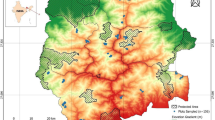Abstract
Mao’ershan region is a representative natural secondary forested region in the eastern mountainous region, northeast of China. Under the support of ARC/INFO, the landscape pattern and landscape diversity of Mao’ershan region were studied by combining the forest type map (1:10000), which was drawn from the aerial photograph (1999), field investigation and land utilization, map (1:10000). The selected indices included patch number, patch size, patch density index, richness index, domonance index, evenness index and diversity index. The results showed that the landscape dominant forest type in Mao’ershan region was softwood broad-leaved forest. In all landscape types,the average patch area of natural secondary forests was bigger than that of artificial forest. The patch density index of each landscape formed in artificial forest was higher than that of natural secondary forest. The landscape diversity index and landscape evenness index of natural forest were highest, the landscape heterogeneity was also, but the landscape dominance was lower. In natural forest, the control effects of landscape elements on landscape-structure, function and its change were weakened. The artificial forest was on the contrary.
Similar content being viewed by others
References
Barrett, G.W. and Peles, J.D. 1994. Optimizing habitat fragmentation: an agrolandscape perspective [J]. Landscape and Urban Planning,28: 99–105.
Chen Liding and Fu Bojie. 1996. Effect of the human being on landscape pattern in Huanghe delta [J]. Acta Ecol Sin,16(4): 337–344. (in Chinese)
Fu Bojieet al. 2001. Principles and applications of landscape ecology. Science Press [M], 351–358. (in Chinese)
Fu Bojie. 1995. The spatial pattern analysis of agricultural landscape in the loses area [J]. Acta Ecol. Sin.,15(2): 113–120. (in Chinese)
Fu Bojie, Chen Iiding. 1996. Landscape diversity types and their ecological significance [J]. Acta geographica sinica,51(5): 454–462. (in Chinese)
Fu Bojie. 1995. Landscape diversity analysis and mapping [J]. Acta ecologica sinica.15(4): 345–350. (in Chinese)
Guo Jinping.2001. Forest landscape ecology reseach [M].Beijing: Beijing University Press, 196–200. (in Chinese)
Li Habin, Wu Yegang. 1992. Mathematic reseach methods of landscape ecology [M]. Beijing: China Science and Technology Press, 209–234. (in Chinese)
Li Shujuan, Sui Yuzhenget al. 2004. Spatial connectivity and distribution of landscape type in the natural secondary forests of eastern mountainous region, northeast china-a case study of Mao’ershan region in Heilongjiang Province [J]. Journal of Forestry Research,15(2): 141–144
Noss, R.F. 1990. Indicators for monitoring biodiverity: A hierachial approach [J]. Conservation Biology,4: 355–364.
Turner, M.G. 1987. Spatial simulation of landscape changes in Georgia: a comparison of 3 transition models [J]. Landscape Ecology,1: 29–36.
Wang Xianli, Xiao Duning and Bu Rencang. 1997. Analysis on the landscape pattern in Liaohe delta Wetland [J]. Acta Ecol. Sin.,17(3): 317–323. (in Chinese)
West, N.E. 1993. Biodiversity of rangelands. Journal of Range Management,46: 2–13.
Wu Jianguo. 2000. Landscape Ecology—Pattern, process, scale and hierarchy [M]. Beijing: Higher Education Press, 100–109. (in Chinese)
Wu Yegang, Li Habin. 1992. The theorical development of landscape ecology [M]. Beijing: China Science and Technology Press, 30–39. (in Chinese)
Zhou Xiaofeng. 1991. Long-term research on forest ecosytems [M]. Harbin: Northeast Forestry University Press, 454–464. (in Chinese)
Author information
Authors and Affiliations
Additional information
Foundation item: This paper was supported by National Key Technologies R&D Program of China during the 10th Five-Year Plan Period (2002BA515B040).
Biography: LI Shu-juan (1977-), female, Lecturer in Ocean University of China, Qingdao 266003, P. R. China
Responsible editor: Zhu Hong
Rights and permissions
About this article
Cite this article
Li, Sj., Sui, Yz., Feng, Hq. et al. Landscape pattern and diversity of natural secondary forests in the eastern mountainous region, northeast China: A case study of Mao’ershan region in Heilongjiang Province. J. of For. Res. 15, 181–186 (2004). https://doi.org/10.1007/BF02911021
Received:
Issue Date:
DOI: https://doi.org/10.1007/BF02911021




